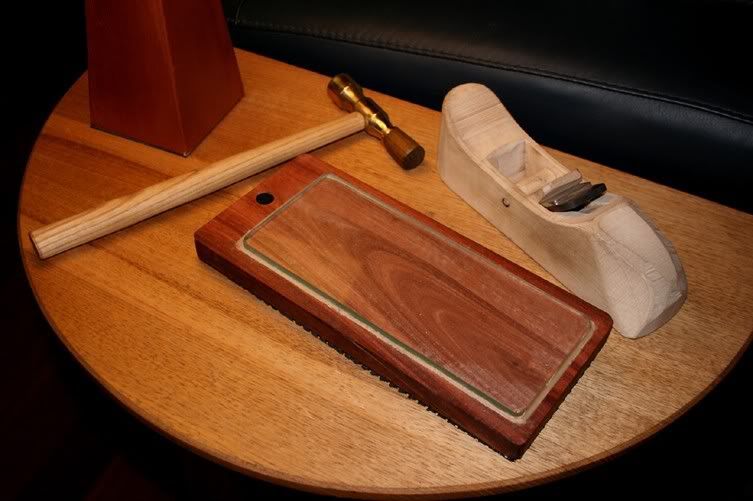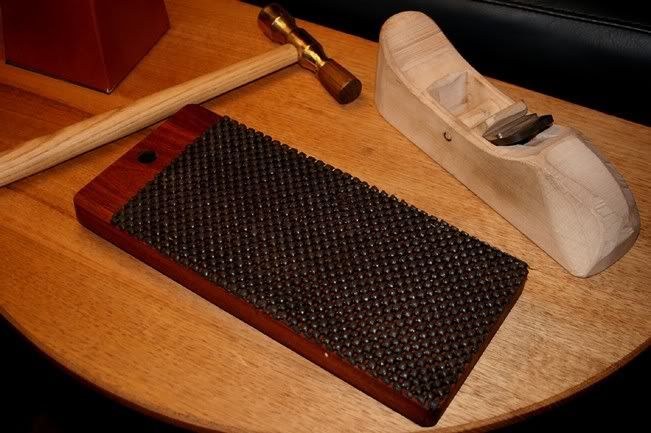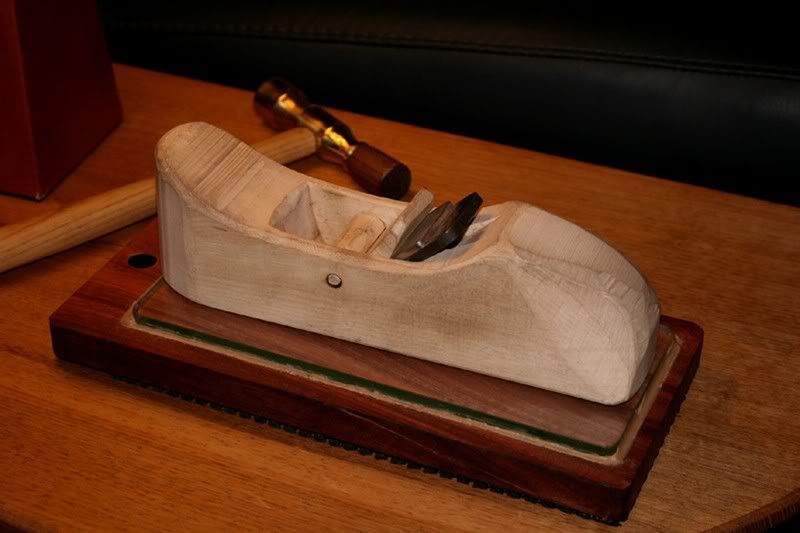 Thanks: 0
Thanks: 0
 Likes: 0
Likes: 0
 Needs Pictures: 0
Needs Pictures: 0
 Picture(s) thanks: 0
Picture(s) thanks: 0
Results 1 to 2 of 2
-
13th October 2008, 01:02 AM #1
 Setting up a Woodie with a Glass Blade Setting Block
Setting up a Woodie with a Glass Blade Setting Block
All those who use wooden and steel planes without adjusters are familiar with the routine of setting up the plane with a freshly honed blade. Typically, this involves placing the plane on a flat service, such as the bench top or a flat board, inserting the blade through the mouth, tapping the wedge into position – or tightening the lever cap – and then adjusting the blade projection in-or-out with a mallet. A rap on the heel will raise the plane, and a tap on the blade will lower it, as will a rap on the toe of the body.
This method has been around for as long as planes have been around. Indeed, Terry Gordon (of HNT Gordon planes) supplies a short hardwood block for this very purpose. He also has a nice tutorial on his website.
For several years I dedicated a hardwood board for setting planes. This was a flat piece of hard Jarrah. It did a decent job and would get close to the setting needed for a fine shaving on a smoother, but I’d still finding I would have to spend time tuning it until it was where I wanted it. Setting up a jack is not critical since one generally wanted a thickish shaving, but a too-thick shaving at the end can destroy all the hard work that preceded it.
There are a few reasons why a plane does not set up well with this method.
The first is that the sole of the plane is not flat or coplanar in the toe-mouth-heel area. A sole with a low mouth will allow the blade to extend further than is wanted for a fine shaving.
Another reason is that the plane is not held firmly against a flat surface when the blade is dropped through the mouth.
And a third is that the setting surface is either too soft or not flat to limit blade projection.
For the past year or so I have been using a sheet of glass to set plane blades. I have mentioned this in an off-the-cuff way before now, but now I will spell it out. I suppose that the thought of dropping a freshly honed blade onto a hard glass surface sounds crazy, but I have never damaged an edge in all the time I have been using this method.

The dimensions for the glass are: 5mm thick and 230mm (9”) x 100mm (4”). This is secured to the wood with silicon at its edge.
Incidentally, that nice plane hammer is one of Dave Anderson’s (Chester Tool Works).
The underside of the setting block has rubber non-slip ..

Place the plane sans wedge and blade on the glass surface. Now slide in the blade and set it down (gently) on the glass so that the blade sits flat along its full length. Continue to press the plane body down very firmly. Insert the wedge and push it in as hard as you can. Use the hammer to secure the wedge (while it lies on the glass) – again, gently!

This should be as much as you need to do. The blade should be square to the sole if you have pushed it through the mouth until it registered with the glass.. It should also have minimal projection – enough for the finest of shavings. It is much easier to tap the blade/rap the toe for increased projection than raise the blade if there is too much projection. The reason is simply because raising the blade also loosens the wedge. And this increases the probability of losing blade squareness.

Set to go.
Regards from Perth
DerekVisit www.inthewoodshop.com for tutorials on constructing handtools, handtool reviews, and my trials and tribulations with furniture builds.
-
13th October 2008 01:02 AM # ADSGoogle Adsense Advertisement
- Join Date
- Always
- Location
- Advertising world
- Posts
- Many
-
14th October 2008, 06:20 PM #2

Another really great idea. Derek you never cease to amaze with your ideas and initiatives.
Many thanks for this simple and excellent suggestion.
Regards from Tele Point
SG

 .... some old things are lovely
.... some old things are lovely
Warm still with the life of forgotten men who made them ........................D.H. Lawrence
Similar Threads
-
Jointer blade setting?
By Mr Brush in forum JOINTERS, MOULDERS, THICKNESSERS, ETCReplies: 4Last Post: 14th September 2008, 11:30 PM -
setting up the blade
By ss_11000 in forum BANDSAWSReplies: 4Last Post: 26th June 2007, 07:04 PM -
ML-392 blade setting technique
By Redback in forum WOODWORK - GENERALReplies: 15Last Post: 8th October 2006, 08:05 PM -
Blade setting jigs.
By tijay in forum HAND TOOLS - POWEREDReplies: 7Last Post: 8th August 2005, 03:22 PM -
Blade setting mallet
By derekcohen in forum HOMEMADE TOOLS AND JIGS ETC.Replies: 12Last Post: 8th July 2005, 09:17 PM






 Reply With Quote
Reply With Quote
